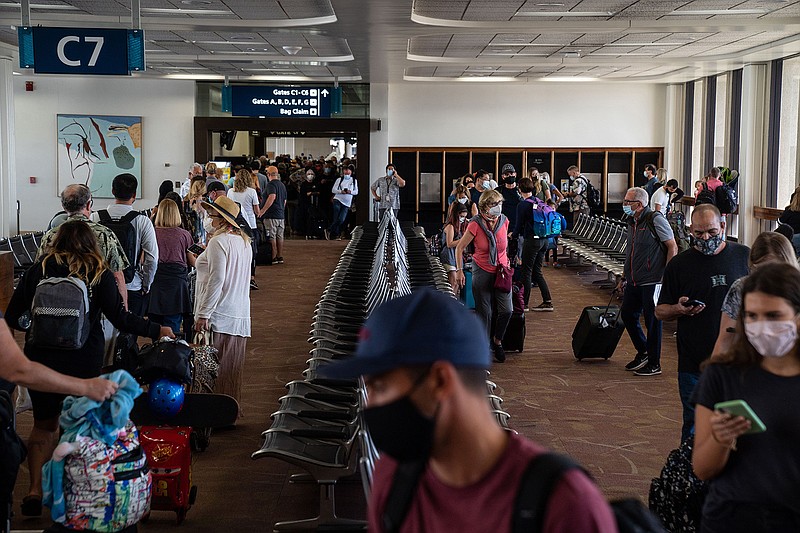HONOLULU - The Hawaiian Islands reopened to tourism Thursday, an occasion that featured ubiquitous face masks, very few leis and thousands of arriving passengers, most of whom had passed preflight coronavirus tests in order to avoid quarantine requirements.
Unlike the trickle of passengers who arrived in the islands over the last six months, this new group of visitors is free to move among hotels (though many remain closed), roam most beaches or dine in restaurants whose dining rooms are approved for 50% capacity. Instead of staying put and isolating for 14 days, as previously required, these visitors can leave when they like.
This move "is right on time," said passenger Chase Halverstadt, 24, lugging two surfboards in the baggage claim area. He was headed to stay with friends on Oahu's North Shore. And then?
"Surf," he said. "About three weeks. Maybe a month."
For islanders whose livelihoods depend on tourism, it's a watershed moment following several false starts as local leaders faced fluctuating infection rates.
"We've been waiting for this day," said Hawaiian Airlines Vice President Jeff Helfrick, addressing the carrier's Flight 3 as it set off from Los Angeles International Airport to Honolulu. The island-bound passengers - about 200 in a 278-seat A330 jet, with most middle seats empty - answered his words with applause.
But the move was not without complications.
Many arriving passengers faced long waits as state officials checked to be sure all arrivals had answered a health questionnaire, had their temperatures taken and shown proof of a negative coronavirus test. An online system for logging the information was supposed to streamline the process, but there were first-day bugs.
One passenger from Los Angeles waited 40 minutes; another, 78 minutes.
Meanwhile, the Honolulu airport's concession workforce has shrunk by hundreds of employees amid cutbacks; most of its shops and restaurants remain closed. Lei greetings, once commonplace, were rare Thursday.
Some neighbor islands are still debating whether to require that visitors pass a second virus test immediately upon arrival if they are continuing on from Oahu to another island.
As restrictions now stand, visitors from the continental U.S. must show a negative test result that had been administered by a state-approved source within 72 hours of the departure of the traveler's flight. To ease that process, several airlines, including Alaska, American, Hawaiian and United, have forged partnerships with testing labs, with test costs from $90 to $250.
Hawaii "is ready" for visitors to return, said Omar Duran, 26, of Los Angeles. Duran was on his way to a reunion with his wife, who has been in Hawaii helping her parents since January.
Together, Duran said, they'll grab a meal from a shrimp truck. And then, "there's a drive-through haunted house at Aloha Stadium. We're supposed to do that tomorrow," he said.
A Hawaiian Airlines spokeswoman said the carrier was encouraged by the burst of bookings that accompanied the opening, but said that the carrier is flying just 33% of the trans-Pacific trips it made last year. Hawaiian Airlines has pledged to keep at least 30% of the seats empty on flights through Dec. 15.
Many of Oahu's leading tourist attractions remain closed, including the Polynesian Cultural Center and famed snorkeling spot Hanauma Bay. But other beaches and some outdoor attractions are open. And indoor attractions such as the Iolani Palace and Bishop Museum reopened Sept. 24 with limited access.
Hawaiian officials first planned to reopen Aug. 1, but delayed when infection rates surged in July. They also enforced their emergency regulations more aggressively than many destinations.
Hawaiian officials said they had made 182 arrests statewide between late March and mid-July, targeting locals and visitors who defied quarantine requirements and other emergency rules. In some cases, the Honolulu Star-Advertiser reported, visitors were obliged to pay $2,000 bail.
Through Tuesday, the state had recorded 172 COVID deaths. Infection rates fell dramatically in early September and have been relatively flat in recent weeks.
For the seven days ending Oct. 14, Hawaii's rate of new cases was 46 per 100,000 residents and Honolulu's was 50, according to a tally by The New York Times.

